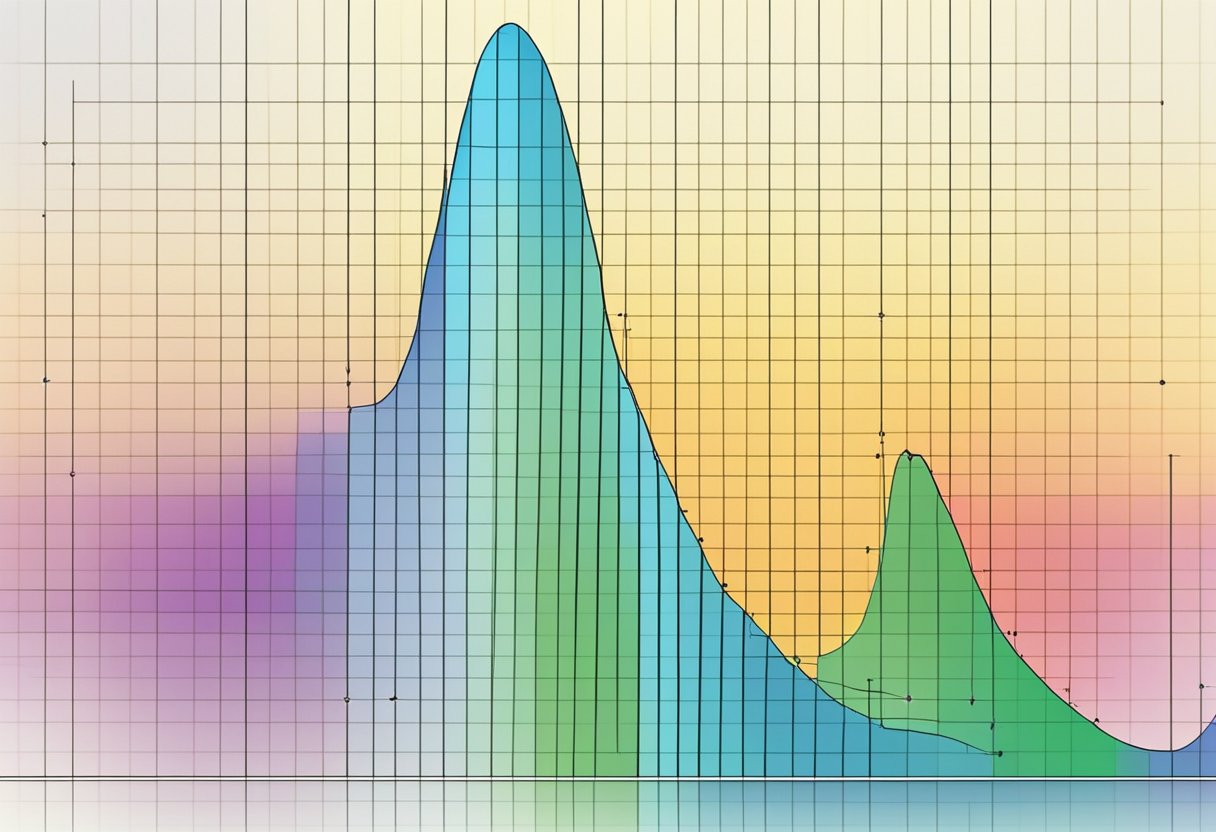JUMP TO TOPIC

To find asymptotes of a rational function, I first consider the form $ f(x) = \frac{p(x)}{q(x)} $ where both $p(x)$ and $q(x)$ are polynomials, and $q(x) \neq 0$.
Asymptotes are lines that the graph of a function approaches but never touches. Determining asymptotes is a way to understand the behavior of a graph at the edges of its domain or towards infinity.
The vertical asymptotes occur at values of $x$ where $q(x) = 0$, as long as those values do not also make $p(x) = 0$, because this can imply a hole rather than an asymptote.
On the other hand, the horizontal asymptotes are based on the degrees of $p(x)$ and $q(x)$. If the degree of $p(x)$ is less than the degree of $q(x)$, the horizontal asymptote is $y = 0$.
If the degrees are equal, the horizontal asymptote is $y = \frac{a}{b}$, where $a$ and $b$ are the leading coefficients of $p(x)$ and $q(x)$, respectively. For situations where the degree of the numerator is one more than the denominator’s, a slant asymptote exists, which can be found using long division of $p(x)$ by $q(x)$.
Catching sight of these invisible lines tells me a story about the function’s journey, and quite fittingly, the adventure of deciphering these beckoning paths begins with a simple step toward infinity.
Steps Involved in Finding Asymptotes in Rational Functions
In mathematics, particularly in calculus, finding the asymptotes of a rational function is a crucial skill. Here, I’ll guide you through the steps to identify horizontal, vertical, and slant asymptotes.

For vertical asymptotes, I find the zeros of the denominator by setting the denominator of my rational function equal to zero, as this denotes points where the function is undefined.
For example, if I have a function $f(x) = \frac{(x+2)}{((x+3)(x-4))}$, I solve the equation $(x+3)(x-4)=0$ to find the vertical asymptotes at $x = -3$ and $x = 4$.
To determine horizontal asymptotes, I compare the degrees of the polynomials in the numerator and denominator. If the degree of the numerator is less than the degree of the denominator, my horizontal asymptote is the x-axis, which is $y = 0$. If they have the same degree, the horizontal asymptote is $y =$ the ratio of the leading coefficients.
| Condition | Horizontal Asymptote |
|---|---|
| Degree(numerator) < Degree(denominator) | $y=0$ |
| Degree(numerator) = Degree(denominator) | $y=$ Ratio of the leading coefficients |
| Degree(numerator) > Degree(denominator) | No horizontal asymptote (check for slant asymptote) |
For a slant asymptote, when the degree of the numerator is one more than the degree of the denominator, I perform a long division of the numerator by the denominator.
The quotient (ignoring the remainder) provides the equation of the slant asymptote.
Below is an example of how the degrees of the numerator and denominator affect the asymptotes:
| Function $f(x)$ | Asymptote Type |
|---|---|
| $\frac{2x+3}{x^2+5}$ | Vertical, Horizontal ($y=0$) |
| $\frac{3x^2}{2x^2+1}$ | Vertical, Horizontal ($y=\frac{3}{2}$) |
| $\frac{x^3-4x}{x^2-1}$ | Vertical, Slant |
Remember, when examining end behavior and approaching discontinuities or the domain‘s infinity, I always consider the function’s limits.
This approach helps me better understand the function’s behavior near its asymptotes in various fields, including science and engineering.
Graphing and Analysis of Rational Functions
When I approach graphing a rational function, I start by identifying its domain. The domain of a rational function includes all real numbers except where the denominator is zero as this would cause a division by zero.
For example, a function with a denominator of $(x-3)(x+2)$ is not defined at $x=3$ and $x=-2$, which means the domain is all real numbers except $3$ and $-2$.
Next, I look for zeros and holes—values where the function equals zero or is undefined due to the numerator and denominator both being zero, respectively.
A hole represents a removable discontinuity, meaning the function can be simplified to remove the discontinuity.
In sketching the graph, locating x– and y-intercepts helps me understand where the graph crosses the axes. X-intercepts occur when the numerator is zero, and the y-intercept is found by evaluating the function at $x=0$.
Identifying asymptotes is crucial. Vertical asymptotes occur at zeros of the denominator that are not also zeros of the numerator, indicating the value of x where the graph approaches infinity. Horizontal asymptotes, determined when the degrees of the numerator and the denominator have certain relationships, show where the graph levels off as $x$ approaches infinity.
Solving applied problems involving rational functions may involve setting up equations representing real-life scenarios and then simplifying, graphing, and analyzing the functions to determine the behavior of the variables involved.
It’s essential to remember that graphs of rational functions often involve non-negative integers and are useful in representing a wide variety of real-world situations.
| Asymptote Type | Condition |
|---|---|
| Vertical | When the denominator equals zero and the numerator does not. |
| Horizontal | If the degree of the numerator is less than the degree of the denominator, the horizontal asymptote is $y=0$. |
Understanding these concepts and performing these steps systematically allows for an accurate graph and analysis of rational functions.
Advanced Concepts in Rational Functions
When working with rational functions, identifying asymptotes is crucial as these lines indicate where the function cannot have values. A vertical asymptote occurs where the denominator of a rational function equals zero, implying division by zero which is undefined.
A horizontal asymptote represents the value that the function approaches as x approaches infinity, reflecting the end behavior of the function.
Let’s consider the average cost function, a practical application of rational functions in economics. The average cost function is used to calculate the cost to produce one additional item.
Mathematically, it is represented as $C(x) = \frac{k(x)}{x} ), where ( k(x)$ is the cost function relating to the total cost of producing x number of items.
In some cases, rates and concentrations in chemistry can also be modeled with rational functions. When determining reaction rates as a function of concentration, the function’s domain represents possible concentration values, and the range represents the associated response in reaction rate.
Understanding asymptotes helps to analyze the function’s behavior at extreme values. To find vertical asymptotes, I factor the function and set the denominator to zero.
With synthetic division, I can further simplify expressions when dealing with polynomials. Analyzing the function as x approaches infinity or x approaches negative infinity, gives us insights into horizontal asymptotes.
| Asymptote Type | Mathematical Approach |
|---|---|
| Vertical | Solve denominator ( = 0 ) |
| Horizontal | Limit of $f(x)$ as $x \to \pm\infty$ |
In summary, I always remember that understanding the end behavior and constraints of rational functions gives invaluable information into real-world phenomena, whether I am calculating costs, rates, or concentrations.
Conclusion
In this guide, we’ve walked through the process of identifying the various types of asymptotes associated with rational functions.
Remember, horizontal asymptotes occur when the degrees of the numerator and denominator inform us about the behavior of a function as ( x ) approaches infinity. Specifically, if the degree of the numerator is less than the degree of the denominator, the horizontal asymptote will be at ( y = 0 ).
On the flip side, when the numerator’s degree exceeds the denominator’s degree, we look out for slant asymptotes.
This involves polynomial long division to find the equation of the slant asymptote. Meanwhile, vertical asymptotes are found by setting the denominator equal to zero and solving for ( x ), keeping in mind that the function is undefined at these points.
I encourage you to practice finding these asymptotes by trying out various rational functions.
Practice will make you more comfortable with the steps and nuances involved. Whether it’s a simple case of comparing degrees for a horizontal asymptote or solving for ( x ) when pinpointing the location of vertical asymptotes, the key is persistent practice.
Understanding asymptotes is fundamental in graphing rational functions. It allows us to sketch the behavior of a function even before plotting specific points. If you want to dive deeper, you might explore the fascinating behaviors of rational functions beyond asymptotes, such as intercepts and regions of increase or decrease.
